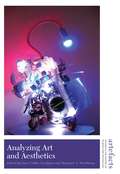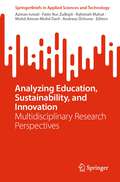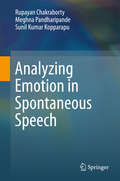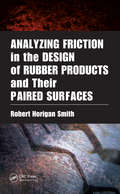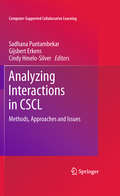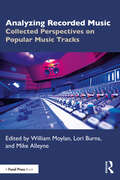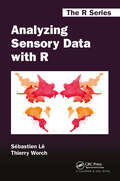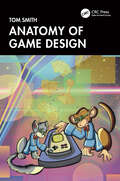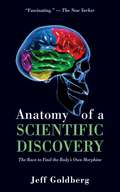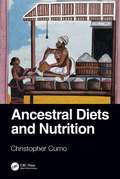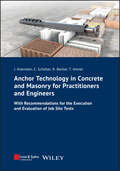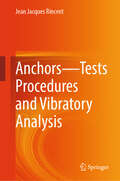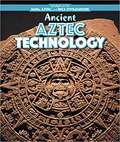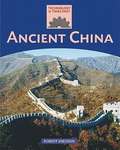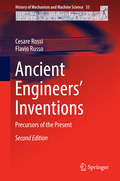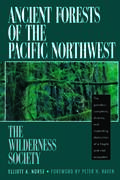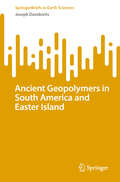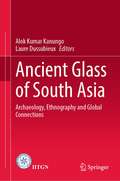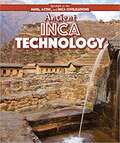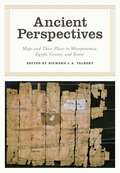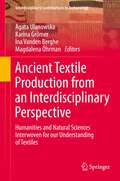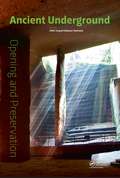- Table View
- List View
Analyzing Art and Aesthetics (Artefacts: Studies in the History of Science and Technology #9)
by Margaret A. Weitekamp Anne Collins GoodyearThis ninth volume of the Artefacts series explores how artists have responded to developments in science and technology, past and present. Rather than limiting the discussion to art alone, editors Anne Collins Goodyear and Margaret Weitekamp also asked contributors to consider aesthetics: the scholarly consideration of sensory responses to cultural objects. When considered as aesthetic objects, how do scientific instruments or technological innovations reflect and embody culturally grounded assessments about appearance, feel, and use? And when these objects become museum artifacts, what aesthetic factors affect their exhibition? Contributors found answers in the material objects themselves. This volume reconsiders how science, technology, art, and aesthetics impact one another.
Analyzing Education, Sustainability, and Innovation: Multidisciplinary Research Perspectives (SpringerBriefs in Applied Sciences and Technology)
by Andreas Öchsner Azman Ismail Mohd Amran Mohd Daril Fatin Nur Zulkipli Rahimah MahatThis book describes a diverse array of studies unravelling the intricate interplay of education, sustainability, and organizational dynamics. From innovative teaching methodologies to sustainability trends and the pandemic's impact, this compendium offers a rich tapestry of insights. This book traverses through a compendium of studies that intricately dissect the synergy between education, sustainability, and organizational dynamics. This book is ideal for academics, practitioners, and curious minds seeking a deeper understanding of these vital contemporary forces.
Analyzing Emotion in Spontaneous Speech
by Sunil Kumar Kopparapu Rupayan Chakraborty Meghna PandharipandeThis book captures the current challenges in automatic recognition of emotion in spontaneous speech and makes an effort to explain, elaborate, and propose possible solutions. Intelligent human-computer interaction (iHCI) systems thrive on several technologies like automatic speech recognition (ASR); speaker identification; language identification; image and video recognition; affect/mood/emotion analysis; and recognition, to name a few. Given the importance of spontaneity in any human-machine conversational speech, reliable recognition of emotion from naturally spoken spontaneous speech is crucial. While emotions, when explicitly demonstrated by an actor, are easy for a machine to recognize, the same is not true in the case of day-to-day, naturally spoken spontaneous speech. The book explores several reasons behind this, but one of the main reasons for this is that people, especially non-actors, do not explicitly demonstrate their emotion when they speak, thus making it difficult for machines to distinguish one emotion from another that is embedded in their spoken speech. This short book, based on some of authors' previously published books, in the area of audio emotion analysis, identifies the practical challenges in analysing emotions in spontaneous speech and puts forward several possible solutions that can assist in robustly determining the emotions expressed in spontaneous speech.
Analyzing Food for Nutrition Labeling and Hazardous Contaminants
by Ike J. Jeon William G. IkinsThis work provides up-to-date information on the various analytical procedures involved in both nutrition labelling and the identification and quantitation of hazardous chemicals in foods. It assesses the relative strengths of traditional and modern analysis techniques. The book covers all mandatory dietary components and many optional nutritients specified by the new labelling regulations of the Food and Drug Administration and the US Department of Agriculture Food Safety and Inspection Service.
Analyzing Friction in the Design of Rubber Products and Their Paired Surfaces
by Robert Horigan SmithTaking a mechanistic approach that emphasizes the physical behavior of rubber as it slides, Analyzing Friction in the Design of Rubber Products and Their Paired Surfaces integrates the engineering and scientific evidence demonstrating that the laws of metallic friction do not apply to rubber. The book also presents a newly developed, scienti
Analyzing Interactions in CSCL: Methods, Approaches and Issues (Computer-Supported Collaborative Learning Series #12)
by Gijsbert Erkens Sadhana Puntambekar Cindy Hmelo-SilverAnalyzing Interactions in CSCL: Methodology, Approaches, and Issues deepens the understanding of ways to document and analyze interactions in CSCL and informs the design of the next generation of CSCL tools. It provides researchers with several alternative methodologies, theoretical underpinnings of the methods used, data indicating how the method worked, guidance for using the methods, implications for understanding collaborative processes and their effect on learning outcomes and implications for design. CSCL research tends to span across several disciplines such as education, psychology, computer science and artificial intelligence. As a result, the methods for data collection and analysis are interdisciplinary, from fields such as sociology, anthropology, psychology, computer science, and artificial intelligence. This book brings perspectives together, and provides researchers with an array of methodologies to document and analyze collaborative interactions.
Analyzing Recorded Music: Collected Perspectives on Popular Music Tracks
by Lori Burns William Moylan Mike AlleyneAnalyzing Recorded Music: Collected Perspectives on Popular Music Tracks is a collection of essays dedicated to the study of recorded popular music, with the aim of exploring "how the record shapes the song" (Moylan, Recording Analysis, 2020) from a variety of perspectives. Introduced with a Foreword by Paul Théberge, the distinguished editorial team has brought together a group of reputable international contributors to write about a rich collection of recordings. Examining a diverse set of songs from a range of genres and points in history (spanning the years 1936–2020), the authors herein illuminate unique attributes of the selected tracks and reveal how the recording develops the expressive content of song performance. Analyzing Recorded Music will interest all those who study popular music, cultural studies, and the musicology of record production, as well as to popular music listeners.
Analyzing Sensory Data with R (Chapman & Hall/CRC The R Series)
by Sebastien Le Thierry Worch Margot BrardChoose the Proper Statistical Method for Your Sensory Data Issue Analyzing Sensory Data with R gives you the foundation to analyze and interpret sensory data. The book helps you find the most appropriate statistical method to tackle your sensory data issue. Covering quantitative, qualitative, and affective approaches, the book presents the big picture of sensory evaluation. Through an integrated approach that connects the different dimensions of sensory evaluation, you’ll understand: The reasons why sensory data are collected The ways in which the data are collected and analyzed The intrinsic meaning of the data The interpretation of the data analysis results Each chapter corresponds to one main sensory topic. The chapters start with presenting the nature of the sensory evaluation and its objectives, the sensory particularities related to the sensory evaluation, details about the data set obtained, and the statistical analyses required. Using real examples, the authors then illustrate step by step how the analyses are performed in R. The chapters conclude with variants and extensions of the methods that are related to the sensory task itself, the statistical methodology, or both.
Anatomy of Game Design
by Tom SmithPeople have played games forever, but it’s only in the past few decades that people really started thinking about what games are, how they work, and how to make them better.Anatomy of Game Design takes some of the most popular and beloved games of all time and dissects them to see what makes them tick. By breaking down the systems and content of each game, the underlying systems of game design are laid bare.Eight games are analyzed – including Settlers of Catan; Centipede; Candy Crush Saga; Papers, Please; Magic: The Gathering; and more – each representing a different genre or era of game design. Each game is discussed in detail, using the same methods for each game. What are the verbs of the game that give the player agency? How do those verbs fit together to form a core loop that makes the game engaging? What are the systems that power the gameplay? What is the larger flow that makes the game interesting over and over again?Each game is then used as an example to tie back to one or more larger topics in game design, such as systems design, randomness, monetization, game theory, and iterative approaches to game development.Key Features: Uses well-known games to provide specific, discrete examples of broader game design theory Discusses eight popular games using the same methodology to allow comparison of different types of games Includes both high-level theory and academic perspective and practical, real-world guidance from a working game designer who has created these games for commercial release Provides clear direction for deeper inquiry into game design or related fields such as psychology, anthropology, game development, or systems thinking
Anatomy of a Scientific Discovery: The Race to Find the Body's Own Morphine
by Jeff GoldbergIn late 1973, scientists John Hughes and Hans Kosterlitz spent the majority of their time in an underfunded, obscure, and cramped laboratory in Aberdeen, Sweden. While working on the brains of pigs, the duo discovered a nonaddictive narcotic chemical that they hoped to later find in human brains. If they could isolate this chemical in humans, perhaps they could find a way to help the world begin to heal itself. Hughes and Kosterlitz's research would inevitably lead them to discover endorphins, the body's own natural morphine and the chemical that makes it possible to feel both pain and pleasure.Announcing their findings to the scientific world thrust Hughes and Kosterlitz in the spotlight and made them celebrities. Soon, scientists all over the world were hastily examining the human brain and its endorphins. In a few years' time, they would use the team's initial research to link endorphins to drug addiction, runner's high, appetite control, sexual response, and mental illnesses such as depression and schizophrenia.In Anatomy of a Scientific Discovery, Jeff Goldberg describes Hughes and Kosterlitz's lives before, during, and after their historic and scientific breakthrough. He also takes a look at the bigger picture, revealing the brutal competition between drug companies to find a way to cash in on this monumental discovery.
Ancestral Diets and Nutrition
by Christopher CumoAncestral Diets and Nutrition supplies dietary advice based on the study of prehuman and human populations worldwide over the last two million years. This thorough, accessible book uses prehistory and history as a laboratory for testing the health effects of various foods. It examines all food groups by drawing evidence from skeletons and their teeth, middens, and coprolites along with written records where they exist to determine peoples&’ health and diet. Fully illustrated and grounded in extensive research, this book enhances knowledge about diet, nutrition, and health. It appeals to practitioners in medicine, nutrition, anthropology, biology, chemistry, economics, and history, and those seeking a clear explanation of what humans have eaten across the ages and what we should eat now. Features: Sixteen chapters examine fat, sweeteners, grains, roots and tubers, fruits, vegetables, and animal and plant sources of protein. Integrates information about diet, nutrition, and health from ancient, medieval, modern and current sources, drawing from the natural sciences, social sciences, and humanities. Provides comprehensive coverage based on the study of several hundred sources and the provision of over 2,000 footnotes. Presents practical information to help shape readers&’ next meal through recommendations of what to eat and what to avoid.
Anchor Technology in Concrete and Masonry for Practitioners and Engineers: With Recommendations for the Execution and Evaluation of Job Site Tests (Bauingenieur-Praxis)
by Rainer Becker Jürgen Küenzlen Eckehard Scheller Thorsten ImmelAnchors are everyday items in construction. However, the ever more complex world of building has led to anchor technology being investigated in more and more scientific detail during the course of product development. New anchor systems take into account the increasing diversity of base materials and the required economic efficiency. The scientific studies result in sometimes highly complex engineering design methods that are specified in numerous codes of practice, e.g. EN 1992-4 “Eurocode 2 – Design of concrete structures – Part 4: Design of fastenings for use in concrete”. As a result, it is no longer possible to design an anchor with a simple, quick and easily grasped manual calculation. However, the experience of the authors over the past 20 years shows that in order to gain the acceptance of users, there is an urgent need to translate academic anchor theory into manageable anchor practice for real building sites. It is exactly that gap that this book intends to fill. The focus is on the practical use of anchors and answering practical questions such as: “Which anchor do I need for my fastening task and what do I have to consider?” To answer this question, the authors guide the reader through the seemingly vast number of anchor systems and provide advice for everyday building situations. The theory regarding the structural behaviour is only explained, and then only briefly, when it helps to solve the fastening task and understand the solution to that task. For clarity, the reader is merely referred to the existing codes of practice and other specialist publications that provide summaries. All authors have been working for many years with a focus on anchors and fastenings, some of them in anchor testing laboratory or as trainers. They are members of various working groups and committees in concrete and masonry structures.
Anchors—Tests Procedures and Vibratory Analysis
by Jean Jacques RincentThis book follows: Ground Anchors: Tension Force Vibratory Analysis JJ Rincent Springer Sept 2024. This new book is a summary of experience gained from the analysis of over 24 000 test curves obtained from 3000 ground anchors analysis. It provides practical feedback on the complexity of non-destructive testing. The test equipment, the rules to obtain interpretable acquisition results. The examples come from trials carried out in Brazil over the last 5 years and finally, the test methodology adopted for this experiment. These tests are generally carried out on ground anchors using strands as reinforcement or rebars several decades old. Information on their length and initial tension force is often non-existent after 40 years. That's why these vibration analysis tests provide the answers and information needed for stability and maintenance diagnostics. The examples chosen concern ground anchors equipped with bars, strands and also for nails, passive ground anchors and micro piles. Tests on prestressed dowels are described, and a test on a reinforcing bar linked to the construction of an early 16th century castle will be carried out. As a reminder that these tests results lead to define the total length of the tie bar, the free length, the diameter of the tie bar, i.e. the reinforcement with its cement grout, and finally the tension force at the time of testing. These data are essential for assessing the stability of retaining walls stabilised by tie rods. It should be stated that static tests, which are difficult to carry out at height, provide no information on lengths and run the risk of breaking old tie rods. All the tests carried out are used to construct the test method that can be adopted, taking into account the feedback acquired from thousands of static tests. For retaining structures and tie rods in particular, access to the head of the tie rods must be preserved in order to: - carry out inspection tests - re-tension the tie rods, if necessary - while protecting them from corrosion. Meeting these conditions means implementing sustainable maintenance of the structures. This test method is a diagnostic tool for ground anchors used by managers of retaining structures to design maintenance projects. The final aim is to increase the durability of the retaining structures. The tests proposed and explained using numerous examples and finally to propose a methodology for carrying out vibration analysis tests on ground anchors, as well as a framework for their interpretation.
Ancient Aztec Technology (Spotlight On The Maya, Aztec, And Inca Civilizations Ser.)
by Emily Jankowski MahoneyTechnology is guiding force in all civilizations. Readers discover the role technology played in ancient Aztec life through text designed to reflect essential social studies curriculum topics. Accessible text introduces readers to the technology used by ancient Aztecs, helping them make their own comparisons to the technology available to us today. Colorful photographs and historical images bring readers into the world of the ancient Aztec people. Primary sources are also included to enhance readers’ learning experience. What did the Aztec people use to make their tools and weapons? Readers will have fun finding out.
Ancient China
by Robert SneddenCovers the inventions and technology used in ancient China and how their ideas influenced technology today.
Ancient Engineers' Inventions: Precursors of the Present (History of Mechanism and Machine Science #33)
by Cesare Rossi Flavio RussoThis book describes the inventions and designs of ancient engineers who are the precursors of the present. The period ranges mainly from 300 B. C. to 1600 A. D. with several exceptions. Many of the oldest inventions are documented by archaeological finds, often very little known, mainly from Pompeii, Herculaneum and Stabiae and reveal a surprising modernity in their conception. Most of the inventions presented in the first four parts of this book were conceived up to the late Roman Empire and may be considered as milestones, each in their respective field. The fifth part concentrates on more recent centuries. The sixth part deals with some building construction techniques. Generally, for each of the presented inventions, three elements of research and reference are provided: written documents (the classics), iconic references (coins, bas-reliefs, etc. ) and archaeological findings. The authors did not write this book for engineers only; hence they describe all the devices without assuming wide technical knowledge. The authors' main aim is to try to communicate their enthusiasm for the inventions and the inventors of the past and to contribute to the fascinating study of the History of Engineering. This second edition includes new topics and chapters that are of special interest to engineers.
Ancient Forests of the Pacific Northwest
by Peter H. Raven The Wilderness Society Elliott A. NorseAncient Forests of the Pacific Northwest provides a global context for what is happening in the Pacific Northwest, analyzing the remaining ancient forest and the threats to it from atmospheric changes and logging. It shows how human tampering affects an ecosystem, and how the Pacific Northwest could become a model for sustainable forestry worldwide.
Ancient Geopolymers in South America and Easter Island (SpringerBriefs in Earth Sciences)
by Joseph DavidovitsThis book presents the study on Ancient Geopolymers in South America and Easter Island regions, exploring the artificial nature of the volcanic rocks used in the construction of Easter Island's statues. Contrary to the belief that the statues were carved and transported, Davidovits suggests they were made on-site using geopolymer technology. He proposes that this knowledge came from Amerindians from the Andes, specifically the Tiahuanaco region near Lake Titicaca. The book is divided into two parts: the first examines geopolymeric artificial stone technologies in the Andes, and the second establishes a connection between these technologies and Easter Island, 3,700 km away. Davidovits' research includes geological expeditions, SEM analysis, petrography, and a comprehensive review of international literature. It is intriguing to observe that in both cases, Pumapunku /Tiwanaku in the Andes and Easter Island, volcanic rocks are involved which contain biological carbon. These discoveries undeniably support the theory of geopolymeric artificial manufacturing, challenging traditional archaeological views.
Ancient Glass
by Julian HendersonThis book is an interdisciplinary exploration of archaeological glass in which technological, historical, geological, chemical and cultural aspects of the study of ancient glass are combined. The book examines why and how this unique material was invented some 4,500 years ago and considers the ritual, social, economic and political contexts of its development. It also provides an in-depth consideration of glass as a material, the raw materials used to make it, and its wide range of chemical compositions in both the East and the West from its invention to the seventeenth century AD. Julian Henderson focuses on three contrasting archaeological and scientific case studies: Late Bronze Age glass, late Hellenistic–early Roman glass, and Islamic glass in the Middle East. He considers in detail the provenances of ancient glass using scientific techniques and discusses a range of vessels and their uses in ancient societies.
Ancient Glass of South Asia: Archaeology, Ethnography and Global Connections
by Laure Dussubieux Alok Kumar KanungoThis book provides a comprehensive research on Ancient Indian glass. The contributors include experienced archaeologists of South Asian glass and archaeological chemists with expertise in the chemical analysis of glass, besides, established ethnohistorians and ethnoarchaeologists. It is comprised of five sections, and each section discusses different aspects of glass study: the origin of glass and its evolution, its scientific study and its care, ancient glass in literature and glass ethnography, glass in South Asia and the diffusion of glass in different parts of the world. The topic covered by the different chapters ranges from the development of faience, to the techniques developed for the manufacture of glass beads, glass bangles or glass mirrors at different times in south Asia, a major glass producing region and the regional distribution of key artefacts both within India and outside the region, in Africa, Europe or Southeast Asia. Some chapters also include extended examples of the archaeometry of ancient glasses. It makes an important contribution to archaeological, anthropological and analytical aspects of glass in South Asia. As such, it represents an invaluable resource for students through academic and industry researchers working in archaeological sciences, ancient knowledge system, pyrotechnology, historical archaeology, social archaeology and student of anthropology and history with an interest in glass and the archaeology of South Asia.
Ancient Inca Technology (Spotlight on the Maya, Aztec, and Inca Civilizations)
by Ryan NagelhoutThe Inca Empire was a complex, highly developed society that ruled ancient Peru for centuries. The civilization grew strong thanks to important advances in technology. This information-rich title covers the Inca’s roads and communications systems, buildings, bridges, terrace farming, and tools. Readers will also learn about important scientific innovations such as calendars, Quipu, the Incas’ understanding of astronomy, and their medicinal practices. Written with age-appropriate language and accompanied by colorful images, this title brings Inca technology to life.
Ancient Inventions: Ahead of Their Time (Into Reading, Level V #34)
by John Francis Teresa TurnerNIMAC-sourced textbook. People have been inventing new ways to meet the challenges of daily life for a very long time. Ancient people faced many of the same basic challenges that we use modern inventions for today. They found many clever ways to do things more quickly and easily. In fact, you might be surprised just how advanced some of their inventions were!
Ancient Perspectives: Maps and Their Place in Mesopotamia, Egypt, Greece and Rome
by Richard J. A. TalbertAncient Perspectives encompasses a vast arc of space and time--Western Asia to North Africa and Europe from the third millennium BCE to the fifth century CE--to explore mapmaking and worldviews in the ancient civilizations of Mesopotamia, Egypt, Greece, and Rome. In each society, maps served as critical economic, political, and personal tools, but there was little consistency in how and why they were made. Much like today, maps in antiquity meant very different things to different people. Ancient Perspectives presents an ambitious, fresh overview of cartography and its uses. The seven chapters range from broad-based analyses of mapping in Mesopotamia and Egypt to a close focus on Ptolemy's ideas for drawing a world map based on the theories of his Greek predecessors at Alexandria. The remarkable accuracy of Mesopotamian city-plans is revealed, as is the creation of maps by Romans to support the proud claim that their emperor's rule was global in its reach. By probing the instruments and techniques of both Greek and Roman surveyors, one chapter seeks to uncover how their extraordinary planning of roads, aqueducts, and tunnels was achieved. Even though none of these civilizations devised the means to measure time or distance with precision, they still conceptualized their surroundings, natural and man-made, near and far, and felt the urge to record them by inventive means that this absorbing volume reinterprets and compares.
Ancient Textile Production from an Interdisciplinary Perspective: Humanities and Natural Sciences Interwoven for our Understanding of Textiles (Interdisciplinary Contributions to Archaeology)
by Karina Grömer Agata Ulanowska Ina Vanden Berghe Magdalena ÖhrmanThe diverse developments in textile research of the last decade, along with the increased recognition of the importance of textile studies in adjacent fields, now merit a dedicated, full-length publication entitled “Ancient Textile Production from an Interdisciplinary Perspective: Humanities and Natural Sciences Interwoven for our Understanding of Textiles”. With this volume, the authors and the editors wish to illustrate to the current impact of textile archaeology on the scholarly perception of the past (not limited to archaeology alone). The volume presents new insights into the consumption, meaning, use and re-use of textiles and dyes, all of which are topics of growing importance in textile research. As indicated by the title, we demonstrate the continued importance of interdisciplinarity by showcasing several ‘interwoven’ approaches to environmental and archaeological remains, textual and iconographic sources, archaeological experiments and ethnographic data, from a large area covering Europe and the Mediterranean, Near East, Africa and Asia. The chronological span is deliberately wide, including materials dating from c. 6th millennium BCE to c. mid-14th century CE. The volume is organised in four parts that aim to reflect the main areas of the textile research in 2020. After the two introductory chapters (Part I: About this Volume and Textile Research in 2020), follow two chapters referring to dyes and dyeing technology in which analytical and material-based studies are linked to contextual sources (Part II: Interdisciplinarity of Colour: Dye Analyses and Dyeing Technologies). The six chapters of Part III: Interdisciplinary Approaches to Textile Tools discuss textiles and textile production starting from the analyses of tools, whether functional or as representative of technological developments or user identity. Archaeological and cultural contexts as well as textile traditions are the main topics of the six chapters in Part IV: Traditions and Contexts: Fibres, Fabrics, Techniques, Uses and Meanings. The two final chapters in Part V: Digital Tools refer to the use of digital tools in textile research, presenting two different case studies.
Ancient Underground Opening and Preservation: Proceedings of the International Symposium on Scientific Problems and Long-term Preservation of Large-scale Ancient Underground Engineering (23-26 October 2015, Longyou, Zhejiang, China)
by Zhifa Yang Chikaosa TanimotoAncient Underground Opening and Preservation contains 59 papers presented at the International Symposium on Scientific Problems and Long-term Preservation of Largescale Ancient Underground Engineering (Longyou, China, 23-26 October 2015). The contributions focus on scientific and technical issues related to long-term preservation of large-scale anc
